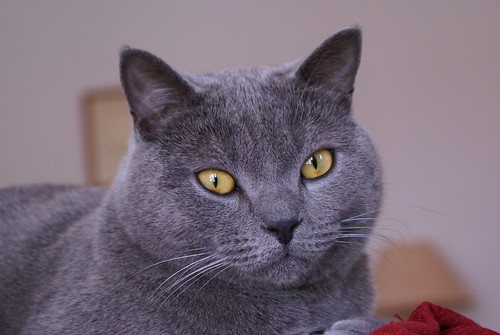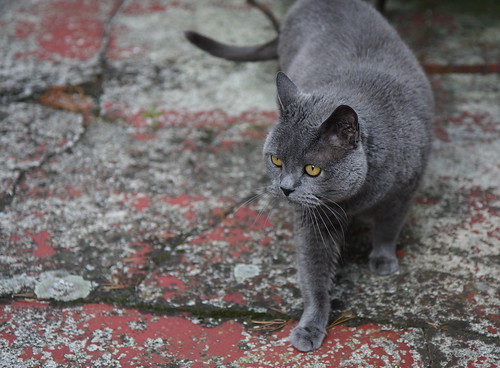
Chartreux by jules_lechat
The Chartreux is an internationally recognized breed of domestic cat from France. The Chartreux is large and muscular, with short fine-boned limbs, big paws, and very fast reflexes. They are known for their blue (grey) water-resistant short hair double-coats and gold- or copper-colored eyes. Chartreux cats are also known for their "smile"; due to the structure of their heads and their long, tapered muzzle, they often appear to be smiling. Chartreux are exceptional hunters and were highly prized by farmers.

Chartreux by bernov69
The first letter of the official name of a Chartreux cat encodes the year of its birth; all Chartreux born in the same year have official names beginning with the same letter. The code letters rotate through the alphabet each year, omitting the letters K, Q, W, X, Y, and Z. For example, a Chartreux born in 2002 would have an official name starting with the letter T (Fogle 2001:128).

Chartreux by jules_lechat
History
There is a legend that the Chartreux are descended from cats brought to France by Carthusian monks to live in the order's head monastery, the Grande Chartreuse, located in the Chartreuse Mountains north of the city of Grenoble (Siegal 1997:27). But in 1972, the Prior of the Grande Chartreuse denied that the monastery's archives held any records of the monks' use of any breed of cat resembling the Chartreux (Simonnet 1990:36–37). Legend also has it that the Chartreux's ancestors were feral mountain cats from what is now Syria, brought back to France by returning Crusaders in the 13th century, many of whom entered the Carthusian monastic order.
The first documented mention of the breed was by the French naturalist Buffon in the 18th century. The breed was greatly diminished during the first World War and wild populations[verification needed] were not seen after World War II. A concerted effort by European breeders kept the breed from extinction. The first Chartreux were brought to the U.S. in 1971 by Helen and John Gammon of La Jolla, California. In 1987, the Cat Fanciers' Association (CFA) advanced the Chartreux breed to championship status (Siegal 1997:27). There are fewer than two dozen active Chartreux breeders in North America as of 2007.
Historically famous Chartreux owners include the French novelist Colette and French general/president Charles de Gaulle.
There is a legend that the Chartreux are descended from cats brought to France by Carthusian monks to live in the order's head monastery, the Grande Chartreuse, located in the Chartreuse Mountains north of the city of Grenoble (Siegal 1997:27). But in 1972, the Prior of the Grande Chartreuse denied that the monastery's archives held any records of the monks' use of any breed of cat resembling the Chartreux (Simonnet 1990:36–37). Legend also has it that the Chartreux's ancestors were feral mountain cats from what is now Syria, brought back to France by returning Crusaders in the 13th century, many of whom entered the Carthusian monastic order.
The first documented mention of the breed was by the French naturalist Buffon in the 18th century. The breed was greatly diminished during the first World War and wild populations[verification needed] were not seen after World War II. A concerted effort by European breeders kept the breed from extinction. The first Chartreux were brought to the U.S. in 1971 by Helen and John Gammon of La Jolla, California. In 1987, the Cat Fanciers' Association (CFA) advanced the Chartreux breed to championship status (Siegal 1997:27). There are fewer than two dozen active Chartreux breeders in North America as of 2007.
Historically famous Chartreux owners include the French novelist Colette and French general/president Charles de Gaulle.